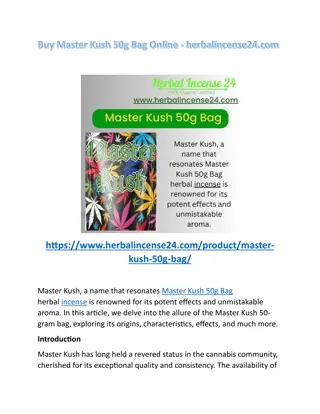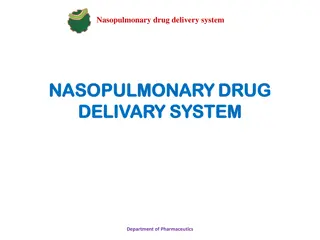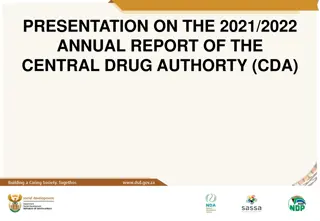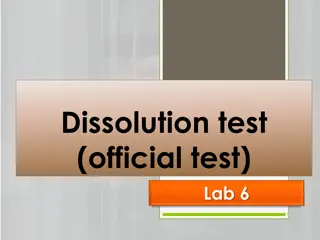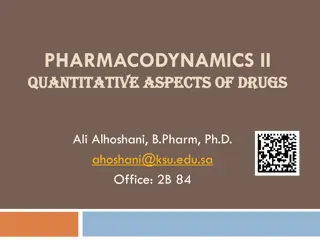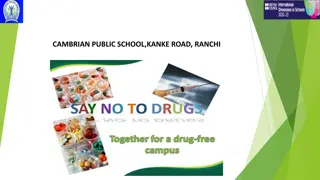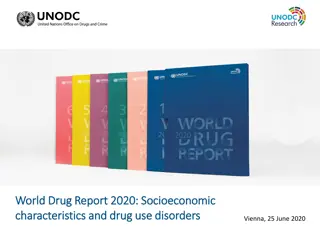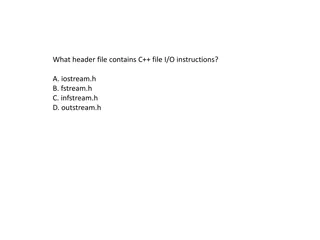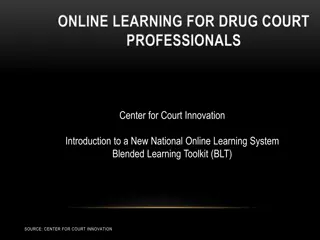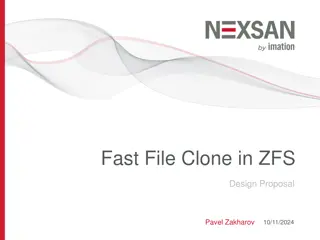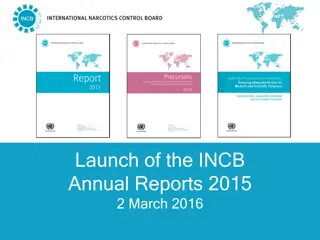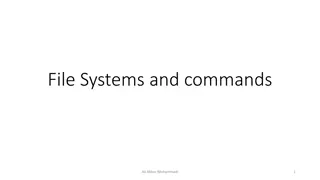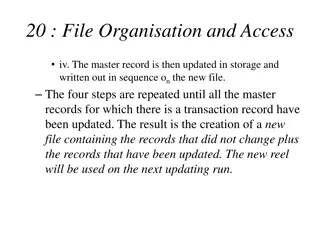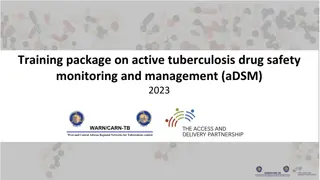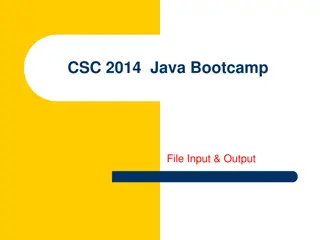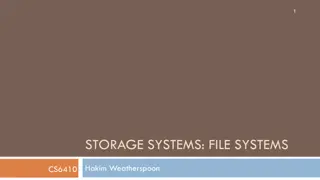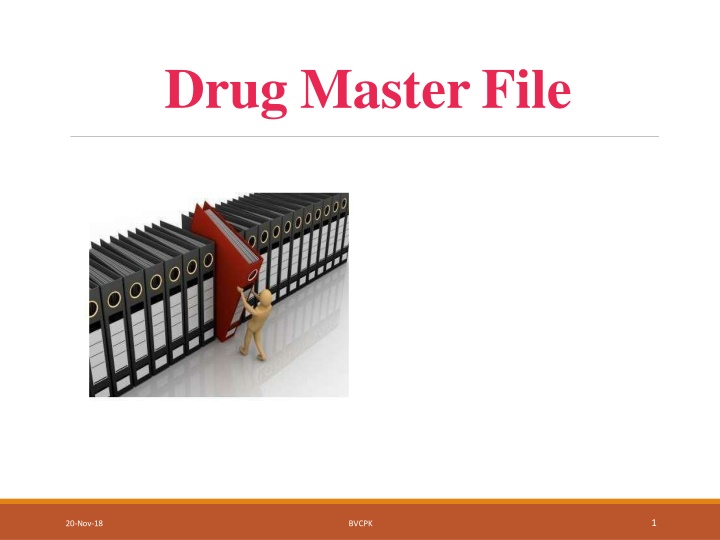
Drug Master Files and Their Importance in FDA Submissions
Learn about Drug Master Files (DMF) and how they are used to provide confidential information to the FDA for human drug manufacturing. Discover the types of DMF, submission process, and essential contents required in a DMF. Understand the significance of DMF in supporting various drug applications and regulatory approvals.
Download Presentation

Please find below an Image/Link to download the presentation.
The content on the website is provided AS IS for your information and personal use only. It may not be sold, licensed, or shared on other websites without obtaining consent from the author. If you encounter any issues during the download, it is possible that the publisher has removed the file from their server.
You are allowed to download the files provided on this website for personal or commercial use, subject to the condition that they are used lawfully. All files are the property of their respective owners.
The content on the website is provided AS IS for your information and personal use only. It may not be sold, licensed, or shared on other websites without obtaining consent from the author.
E N D
Presentation Transcript
Drug Master File 1 20-Nov-18 BVCPK
Contents Introduction Types of DMF Submission of DMF 1.Transmittal letter 2.Administrative Information Authorization to refer DMF Holder Obligation Closure of DMF file Conclusion 2 20-Nov-18 BVCPK
Introduction ADrug Master File (DMF) is a submission to the Food and Drug Administration (FDA) that may be used to provide confidential detailed information about facilities, processes, or articles used in the manufacturing, processing, packaging, and storing of one or more humandrugs. The submission of a DMF is not required by law or FDAregulation and a DMF is submitted solely at the discretionof the holder (a person who owns a DMF). The information contained in the DMF may be used to support an Investigational New Drug Application (IND), a New Drug Application (NDA), an Abbreviated New Drug Application (ANDA), another DMF, an ExportApplication, or amendments and supplements to any ofthese. But a DMF is NOTa substitute for an IND, NDA,ANDA, or ExportApplication. 3 20-Nov-18 BVCPK
Drug Master Files are provided for in 21 CFR 314.420. This guideline is intended to provide DMF holders with procedures acceptable to the agency for preparing and submitting a DMF. The guideline discusses types of DMF's, the information needed in each type, the format of submissions to a DMF, the administrative procedures governing review of DMF's, and the obligations of the DMF holder. DMF's are generally created to allow a party other than the holder of the DMF to reference material without disclosing to that party the contents of the file. When an applicant references its own material, the applicant should reference the information contained in its own IND, NDA, or ANDAdirectly rather than establishing a new DMF. 4 20-Nov-18 BVCPK
Types of Drug master file TYPES ESSENTIAL CONTENTS Manufacturing site, facilities, operating procedure and personnel I Drug substance & intermediate, material used and drug product II III Packagingmaterial Excipient , flavor , essence, colorant, & material used in preparation IV V FDA accepted reference information 5 20-Nov-18 BVCPK
Type I: Manufacturing Site, Facilities, Operating Procedures, and Personnel A Type I DMF is recommended for a person outside of the United States to assist FDA in conducting on site inspections of their manufacturing facilities. The DMF should describe the manufacturing site, equipment capabilities, and operational layout. AType I DMF is normally not needed to describe domestic facilities, except in special cases, such as when a person is not registered and not routinely inspected. The description of the site should include actual site address, and a map showing its location with respect to the nearest city.An aerial photograph and a diagram of the site may be helpful. A diagram of major production and processing areas is helpful for understanding the operational layout. Major equipment should be described in terms of capabilities, application, and location. Make and model would not normally be needed unless the equipment is new or unique. A diagram of major corporate organizational elements, with key manufacturing, quality control, and quality assurance positions highlighted, at both the manufacturing site and corporate headquarters, is also helpful. 6 20-Nov-18 BVCPK
Type II: Drug Substance, Drug Substance Intermediate, and Material Used in Their Preparation, or Drug Product AType II DMF should, in general, be limited to a single drug intermediate, drug substance, drug product, or type of material used in their preparation. (1) Drug Substance Intermediates, Drug Substances, and Material Used in Their Preparation Guideline for Submitting Supporting Documentation in DrugApplications for the Manufacture of Drug Substances. Guideline for the Format and Content of the Chemistry, Manufacturing, and Controls Section of anApplication. (2) Drug Product Guideline for the Format and Content of the Chemistry, Manufacturing, and Controls Section of anApplication. Guideline for Submitting Documentation for the Manufacture of and Controls for Drug Products Guideline for Submitting Samples andAnalytical Data for MethodsValidation 7 20-Nov-18 BVCPK
Type III: Packaging Material Each packaging material should be identified by the intended use, components, composition, and controls for its release. The names of the suppliers or fabricators of the components used in preparing the packaging material and the acceptance specifications should also be given. Data supporting the acceptability of the packaging material for its intended use should also be submitted as outlined in the "Guideline for Submitting Documentation for Packaging for Human Drugs and Biologics." Toxicological data on these materials would be included under this type of DMF, if not otherwise available by cross reference to another document. 8 20-Nov-18 BVCPK
Type IV Excipient, Colorant, Flavor, Essence, or Material Used in Their Preparation Each additive should be identified and characterized by its method of manufacture, release specifications, and testing methods. Toxicological data on these materials would be included under this type of DMF, if not otherwise available by cross reference to another document. Usually, the official compendia and FDAregulations for color additives (21 CFR Parts 70 through 82), direct food additives (21 CFR Parts 170 through 173), indirect food additives (21 CFR Parts 174 through 178), and food substances (21 CFR Parts 181 through 186) may be used as sources for release tests, specifications, and safety. Guidelines suggested for a TypeII DMF may be helpful for preparing a TypeIV DMF. Type V: FDAAccepted Reference Information FDA discourages the use of Type V DMF's for miscellaneous information, duplicate information, or information that should be included in one of the other types of DMF's. If any holder wishes to submit information and supporting data in a DMF that is not covered by TypesI through IV, a holder must first submit a letter of intent to the Drug Master File Staff .FDAwill then contact the holder to discuss the proposed submission. 9 20-Nov-18 BVCPK
Submissionsto DrugMaster Files Each DMF submission should contain a transmittal letter, administrative information about the submission, and the specific information to be included in the DMF as described in thissection. The DMF must be in the English language. Whenever a submission contains information in another language, an accurate certified English translation must also be included. Each page of each copy of the DMF should be dated and consecutively numbered. An updated table of contents should be included with each submission. 10 20-Nov-18 BVCPK
A. Transmittal Letters A.1. Original Submissions Identification of submission: Original, the type of DMF as classified in Section III, its subject. Identification of the applications, if known, that the DMF is intended to support, including the name and address of each sponsor, applicant, or holder, and all relevant document numbers. Signature of the holder or the authorized representative. Typewritten name and title of the signer. A. 2.Amendments Identification of submission:Amendment, the DMF number, type of DMF, and the subjectof the amendment. Adescription of the purpose of submission, e.g., update, revised formula, or revised process. Signature of the holder or the authorized representative. Typewritten name and title of the signer. 11 20-Nov-18 BVCPK
B.Administrative Information B.1. Original Submissions a. Names and addresses of the following: 1) DMF holder. 2) Corporateheadquarters. 3) Manufacturing/processing facility. 4) Contact for FDAcorrespondence. 5)Agent(s), if any. b. The specific responsibilities of each person listed in any of the categories. c. Statement of commitment. Asigned statement by the holder certifying that the DMF is current and that the DMF holder will comply with the statements made in it. B.2.Amendments 12 20-Nov-18 BVCPK
General Information and Suggestions to prepare DMF 1. EnvironmentalAssessment 2. Stability 3. Format,Assembly, and Delivery 4. An original and duplicate are to be submitted for all DMFsubmissions. Drug Master File holders and their agents/representatives should retain a complete reference copy that is identical to, and maintained in the same chronological order as, their submissions to FDA. 5. The original and duplicate copies must be collected, fully assembled. Each volume of a DMF should, in general, be no more than 2 inches thick. For multivolume submissions, number each volume. For example, for a 3 volume submission, the volumes would be numbered 1 of 3, 2 of 3, and 3 of 3. 6. U.S. standard paper size (8-1/2 by 11 inches) is preferred. Paper length should not be less than 10 inches nor more than 12 inches. However, it may occasionally be necessary to use individual pages larger than standard paper size to present a floor plan, synthesis diagram, batch formula, or manufacturing instructions. Those pages should be folded and mounted to allow the page to be opened for review without disassembling the jacket and refolded without damage when the volume is shelved. 7. Delivery to FDA 13 20-Nov-18 BVCPK
Authorization ToReferADrug Master File Letter ofAuthorization to FDA Before FDA can review DMF information in support of an application, the DMF holder must submit in duplicate to the DMF a letter of authorization permitting FDA to refer the DMF. If the holder cross refers its own DMF, the holder should supply in a letter of authorization the information designated by items 3, 5, 6, 7, and 8 of this section. The holder does not need to send a transmittal letter with its letter of authorization. 14 20-Nov-18 BVCPK
The letter of authorizationshould include the following: The date. Name of DMF holder. DMF number. Name ofpersons authorized to incorporate information in the DMF by reference. Specificproductscoveredby the DMF. Submission dates Section numbers and/or page numbers to be referenced. Statement of commitment that the DMF is currentand that the DMF holder will comply with the statementsmade in it. Signature of authorizingofficial. Typed name and title of official authorizing reference to the DMF. 15 20-Nov-18 BVCPK
Drug Master File Review ADMFIS NEVERAPPROVED OR DISAPPROVED. The agency will review information in a DMF only when an IND sponsor, an applicant for an NDA,ANDA, or ExportApplication, or another DMF holder incorporates material in the DMF by reference.As noted, the incorporation by reference must be accompanied by a copy of the DMF holder's letter of authorization. If FDA reviewers find deficiencies in the information provided in a DMF, a letter describing the deficiencies is sent to the DMF holder. At the same time, FDA will notify the person who relies on the information in the deficient DMF that additional information is needed in the supporting DMF. The general subject of the deficiency is identified, but details of the deficiency are disclosed only to the DMF holder. When the holder submits the requested information to the DMF in response to the agency's deficiency letter, the holder should also send a copy of the accompanying transmittal letter to the affected persons relying on the DMF and to the FDA reviewing division that identified the deficiencies.The transmittal letter will provide notice that the deficiencies have been addressed. 16 20-Nov-18 BVCPK
Holder Oligation Any change or addition, including a change in authorization related to specific customers, should be submitted in duplicate and adequately cross referenced to previoussubmission. The referenceshould include the date, volume,section, and/or page number affected. 17 20-Nov-18 BVCPK
A. Notice RequiredforChanges to a Drug Master File A holder must notify each affected applicant or sponsor who has referencedits DMF of any pertinent change in the DMF (21 CFR 314. 420(c)). B. Listing of PersonsAuthorizedToReferto a Drug MasterFile A DMF is required to contain a complete list of persons authorized to incorporateinformation in the DMF by reference[21 CFR 314.420(d)]. The holder should update the list in the annual update. The updated list should contain the holder's name, DMF number, and the date of the update. The update should identify by name (or code) the information that each person is authorized to incorporateand give the location of that information by date, volume, and page number. C.Annual Update The holder should providean annual report on the anniversary date of the original submission. If the subject matter of the DMF is unchanged, the DMF holder providea statement that the subject matter of the DMF is current. Failure to update or to assure FDA annually that previously submitted material and lists in the DMF remain currentcan cause delays in FDAreview of a pending IND, NDA, ANDA, Export Application, or any amendment or supplement to such application; and FDA can initiate procedures for closure of the should 18 20-Nov-18 BVCPK
D.Appointment of anAgent When an agent is appointed, the holder should submit a signed letter of appointment to the DMF giving the agent's name, address, and scope of responsibility(administrativeand/or scientific). Domestic DMF holders do not need to appoint an agent or representative. E. Transferof Ownership To transfer ownership of a DMF to another party, the holder should so notify FDAand authorizedpersons in writing.The letter should include the following: 1. Name of transferee 2. Address of transferee 3. Name of responsible officialof transferee 4. Effective date of transfer 5. Signature of the transferring official 6.Typewritten name and title of the transferringofficial.The new holder should submit : Aletter of acceptance of the transfer An update of the information contained in the DMF,where appropriate. Any change relating to the new ownership (e.g., plant location and methods) should be included 19 20-Nov-18 BVCPK
Closure OfADrug Master File A holder who wishes to close a DMF should submit a request to the Drug Master File Staff stating the reason for the closure. The request should include a statement thatthe holder's obligations. The Agency may close a DMF that does not contain an annual update of persons authorized to incorporate information in the DMF by reference and a list of changes made since the previous annual report. The holder will be notified of FDA'sintent to close the DMF. 20 20-Nov-18 BVCPK
Conclusion A Drug Master File (DMF) is a submission to the Food and Drug Administration (FDA) that may be used to provideconfidential detailed information about facilities, processes, or articles used in the manufacturing, processing, packaging, and storing of one or more humandrugs. DMF may be used to support an IND , NDA, INDA. So country wise format of DMF changed as DMFs in the United States and DMFs in Europe. 21 20-Nov-18 BVCPK
22 20-Nov-18 BVCPK

